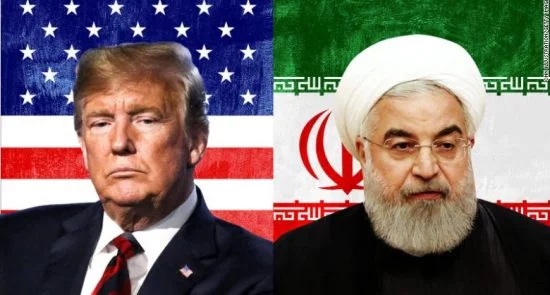Asia May 6, 2019
Short Link:The Lesson of Iran’s Sanction is Clear: It Doesn’t Produce Regime Change
President Trump and his aides say the outcome of their confrontation with Iran is already clear: They’re winning.
Ariana News Agency-
Iran has fallen into a deep recession; its economy may shrink 6% this year. Inflation is heading toward 40%, and the nation’s currency has virtually collapsed. Newly tightened oil sanctions have deprived the Tehran government of at least $10 billion in revenue.
But shrinking Iran’s economy was never the main U.S. goal. The sanctions were intended as a means toward larger ends: forcing the Tehran regime to stop supporting militant groups across the Middle East, accept U.S.-imposed restrictions on its military power, and maybe collapse altogether — presumably to be succeeded by a friendlier government.
None of those achievements is in view, and they’re not likely to happen soon.
That shouldn’t be surprising. Economic sanctions often fail.
The United States imposed a trade embargo on Fidel Castro’s Cuba in 1962; more than half a century later, the regime he founded is still in place. Iran has been under U.S. sanctions since its Islamic Revolution in 1979; 40 years later, the mullahs haven’t budged. The United Nations imposed sanctions on Iraq after Saddam Hussein invaded Kuwait in 1990; it took a U.S.-led invasion in 2003 to end his reign.
David S. Cohen, a former top Treasury Department official who directed Iran sanctions under President Obama, says the lesson is clear: Sanctions don’t produce regime change.
“There [are] no historical precedents for governments falling as a direct result of long-term sanctions pressure,” he wrote recently in Foreign Affairs.
In a few cases, sanctions have succeeded — not in producing regime change, but in prompting negotiations.
In South Africa, international sanctions helped nudge the white apartheid regime to reach a deal with Nelson Mandela’s African National Congress in 1993 to start a transition toward black majority rule. But so did years of bitter protests and the loss of U.S. support after the Cold War ended.
In Iran, multilateral sanctions pushed the Tehran regime toward the 2015 agreement to dismantle its nuclear program. And in North Korea, sanctions presumably impelled Kim Jong Un to freeze his nuclear program and meet twice with President Trump, although those talks have stalled.
Those cases have one important element in common: The regime under sanctions was offered a deal.
But that’s not what Trump has proposed for Iran. Instead, his administration has issued 12 demands, including stricter limits on nuclear research and missile development, withdrawal of forces from Syria, an end to support for pro-Iranian groups in other countries, a promise to cease anti-Israel rhetoric, and domestic political reforms.
In Washington’s view, those are all worthy goals. In Tehran’s, they look like capitulation, not a serious offer to begin talks.
Sanctions will achieve a more modest goal: They will deprive Iran of money it could use for nefarious purposes. That’s what Trump administration officials emphasized last month when they announced their latest measures.
“The goal remains simple: to deprive the outlaw regime of the funds it has used to destabilize the Middle East,” said Secretary of State Michael R. Pompeo.
Whether Iran will trim its support for militant groups isn’t clear. But if the goal is merely to cut Iran’s revenue, then the White House is likely to claim any drop in oil exports as a win.
History suggests cutting oil revenues won’t end Iran’s support for militant groups, however. Iran subsidized Hezbollah in Lebanon, sent armed militias into Iraq and supported Syrian President Bashar Assad despite tough international sanctions before the nuclear accord was signed in 2015.
The White House sanctions campaign also should be weighed against the potential cost to U.S. relations with other countries, including several close allies.
As of May 1, according to the Trump administration, no country may buy oil from Iran. That includes China, Tehran’s largest customer and a major U.S. trading partner, as well as India, the world’s largest democracy, and Turkey, a NATO ally that shares a border with Iran.
If they violate Trump’s order, the Treasury Department may cut them off from the U.S. financial system.
U.S. officials have warned those countries that they must now choose: They can deal with the United States or Iran, but not both. For major oil companies, it’s not a difficult choice; access to the U.S. banking system is essential to their businesses.
But China, India and other countries have relied on Iran for a significant part of their energy supply. Now they must hope Saudi Arabia and other suppliers can provide the oil they need.
And they face that disruption thanks to a White House policy they don’t support: Trump’s decision last year to withdraw from the nuclear deal and impose sanctions instead.
“There’s tremendous diplomatic blowback,” Elizabeth Rosenberg, who worked on sanctions in the Obama administration, told me. “It translates into a loss of trust and willingness to cooperate on … security, global health, migration — everything.”
If other countries are hit by sanctions, they could band together into what Rosenberg called “coalitions of the sanctioned,” united by a sense of grievance against the United States. They ultimately could find ways around the U.S. financial system, a loss for America.
Trump and his aides have designed the new sanctions so they can claim a win. The sanctions could turn out to be a losing proposition instead — with no real benefits for U.S. policy and hidden costs that outweigh them.
Doyle McManus, New York Times




